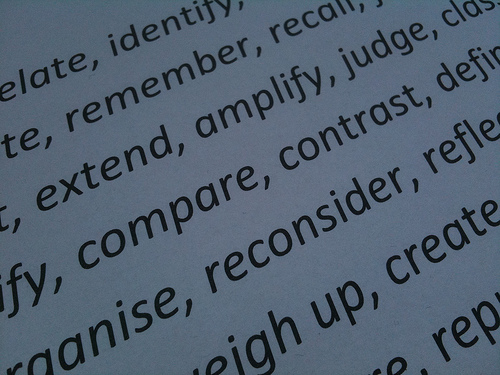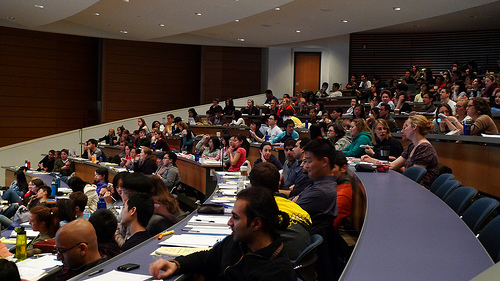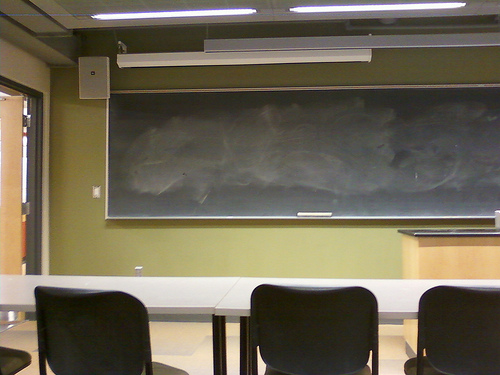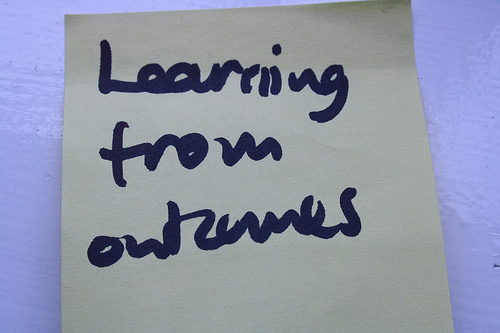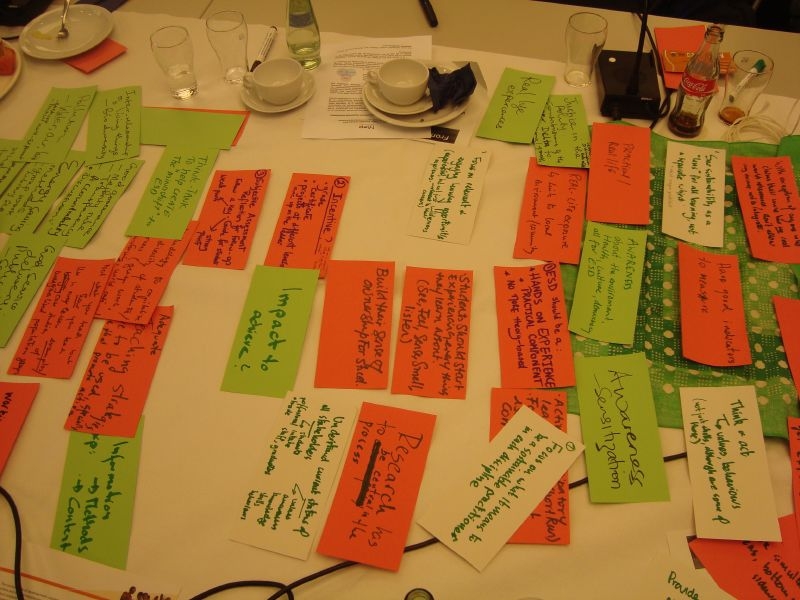
Source: http://www.flickr.com/photos/21218849@N03/3482802808/sizes/o/in/photostream/
Examples of program-level learning outcomes
I recently conducted a search for examples of program-level learning outcomes from a variety of institutions and disciplines. The task turned out to be more challenging than I ever could have imagined, especially from the Canadian context. I firmly believe that every program at every institution should have early articulated and publically accessible learning outcome statements. No one should be left to interpret the intended program learning outcomes from the compilation of courses in the Institution’s academic calendar – faculty, staff, or students (current, prospective and alumni). Nor should these learning outcomes be hidden within reports, to be viewed only by internal and external program review committees. They should inform and bring meaning to our everyday teaching and learning experiences. They should help to create a living curriculum, which is intentional and aligned, as well as continually monitored, reviewed and renewed based on a philosophy of continuous improvement.
Here are a few examples of program-level learning outcomes from a variety of disciplines that I came across in my search.
University of British Columbia, Materials Engineering
Materials Engineers are experts on the entire life cycle of materials, including recovery of materials from minerals, making engineered materials, manufacturing materials into products, understanding and evaluating materials performance, proper disposal and recycling of materials, and evaluating societal and economic benefits. At the end of the program, students will be able to:
1. Characterize and select materials for design by evaluating the linkages between material properties, microstructures and processing.
2. Analyze materials engineering problems using a balance of mathematics, physics and chemistry including thermodynamics, mass, momentum and energy transport, kinetics and mechanics of materials.
3. Solve materials engineering problems. Identify and formulate problems, develop and apply analytical and experimental methods of investigation, identify contributing factors and generate, validate, and evaluate alternative solutions.
4. Design processes for the extraction, synthesis and processing of materials to meet technical, economic, environmental and ethical needs and constraints.
5. Communicate effectively in a professional environment through technical reports and presentations. Articulate and justify technical solutions to diverse audiences.
6. Recognize and evaluate the societal benefits of materials engineering. Appreciate and evaluate the environmental and societal impact of materials. Recognize the importance of professional and ethical responsibilities, the evolving nature of materials engineering and the importance of lifelong learning.
http://www.mmat.ubc.ca/prospective_students/undergraduate/program/outcomes.php (accessed, Feb. 11, 2011)
Qatar University, Department of Architecture and Urban Planning
The objectives of the Bachelor of Architecture program are translated into a number of learning outcomes. These outcomes are directly related to the profession of architecture, the way in which it is practiced, and the knowledge components necessary for such a practice. The following list of outcomes represent the minimum learning outputs expected and therefore they are not exclusive. Specific exercises and individual and group projects may achieve additional learning outcomes:
1. An ability to conceptualize and coordinate designs, addressing social, cultural, environmental and technological aspects of architecture
2. An ability to recognize the dialectic relationship between people and the built environment in the GCC/Arab region
3. An ability to apply and integrate computer technology in design processes and products
4. An ability to utilize cutting edge building technology in design
5. An ability to apply visual and verbal communication skills at various stages of architectural design and project delivery processes
6. An ability to critically analyze building designs and conduct post occupancy evaluation studies
7. An ability to employ architectural research methods including data collection and analysis to assess and propose improvements in existing built environments
8. An ability to work collaboratively with teams of architects and various interdisciplinary design teams involved in the building industry
9. An ability to recognize diversity of needs, values, behavioral norms, social patterns as they relate to the creation of the built environment
http://www.qu.edu.qa/engineering/architecture/programs/arch/outcomes.php (accessed Feb. 11, 2011)
Academy of Art University, San Fransisco, Master of Fine Arts
Graduates of the Academy of Art University will demonstrate the ability to:
- Produce a body of work suitable for seeking professional opportunities in their chosen field of art and design.
- Solve creative problems within their field of art and design, including research and synthesis of technical, aesthetic, and conceptual knowledge.
- Communicate their ideas professionally and connect with their intended audience using visual, oral, and written presentation skills relevant to their field.
- Execute technical, aesthetic, and conceptual decisions based on an understanding of art and design principles.
- Evaluate work in their field, including their own work, using professional terminology.
- Recognize the influence of major cultural and aesthetic trends, both historical and contemporary, on art and design products.
- Learn the professional skills and behaviors necessary to compete in the global marketplace for art and design.
http://www.academyart.edu/interior-design-school/mfa_program.html (accessed Feb. 11, 2011)
Indiana University – Purdue University Fort Wayne, Bachelor of Arts, Sociology
The student learning outcomes for the degree are as follows:
1. Theoretical: Graduates will be able to analyze and evaluate major theoretical perspectives in sociology.
a. Graduates should be able to identify the general theoretical orientation.
b. Graduates should be able to apply theoretical analyses of social structure and social processes.
c. Graduates should be able to interpret social issues in terms of the major theoretical perspectives.
2. Methodological: Graduates will be able to utilize and evaluate research methods and data analysis used in sociology.
a. Graduates should be able to demonstrate appropriate use of both quantitative and qualitative methodologies.
b. Graduates should be able to evaluate different research methods.
c. Graduates should be able to interpret the results of data gathering.
d. Graduates should be able to demonstrate appropriate use of statistical techniques.
e. Graduates should be able to demonstrate competent use of statistical software.
3. Critical Thinking: Graduates will be able to evaluate critically arguments and situations.
a. Graduates should be able to critically evaluate theoretical arguments.
b. Graduates should be able to develop evidence-based arguments.
c. Graduates should be able to critically evaluate published research.
4. Communication Skills: Graduates will be able to communicate effectively in both written and oral form.
a. Graduates should be able to write a research report.
b. Graduates should be able to develop an oral research report.
5. Professional Ethics: Graduates will be knowledgeable of appropriate ethics concerning both professional conduct and the use of human subjects.
a. Graduates should demonstrate a mastery of the ethical standards for conducting research with human subjects.
b. Graduates should demonstrate an understanding of the ethical standards of the American Sociological Association.
http://bulletin.ipfw.edu/preview_program.php?catoid=19&poid=3609&returnto=search (accessed Feb. 11, 2011)


